七年级英语上册Unit 5 Do you have a soccer ball?SectionA(1a-2d)课件(共有PPT27张,无音频)
文档属性
| 名称 | 七年级英语上册Unit 5 Do you have a soccer ball?SectionA(1a-2d)课件(共有PPT27张,无音频) | 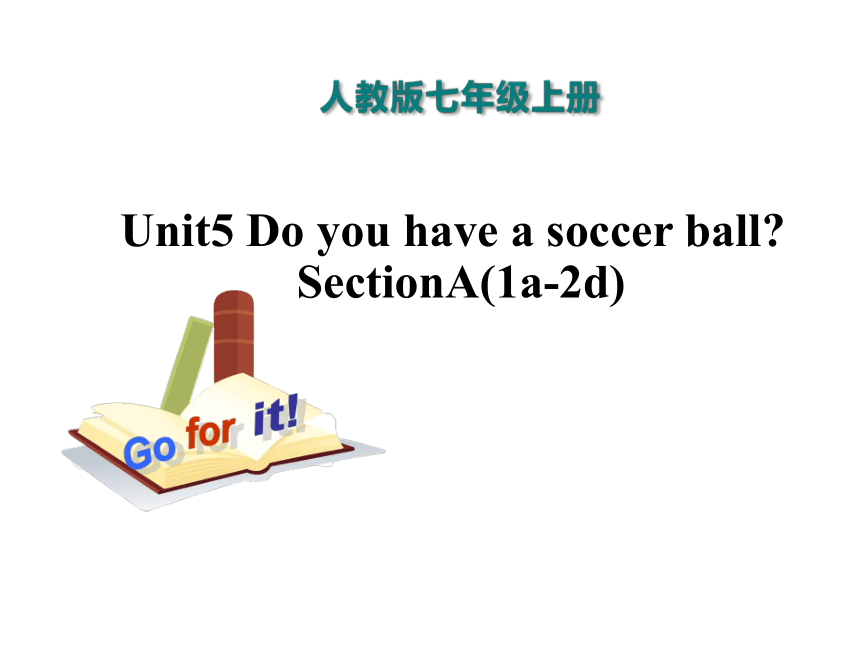 | |
| 格式 | zip | ||
| 文件大小 | 1.4MB | ||
| 资源类型 | 教案 | ||
| 版本资源 | 人教新目标(Go for it)版 | ||
| 科目 | 英语 | ||
| 更新时间 | 2021-12-31 11:29:08 | ||
图片预览

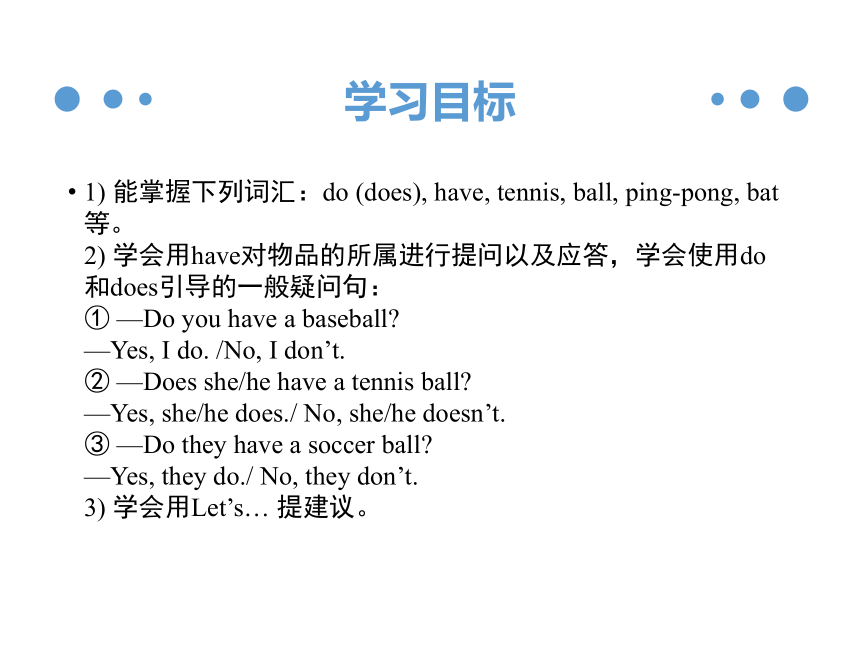

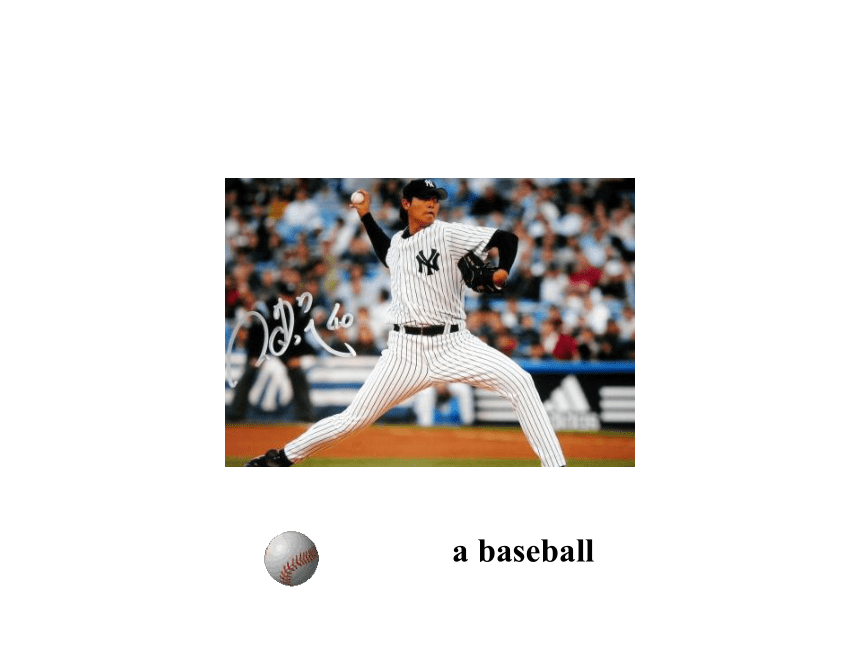
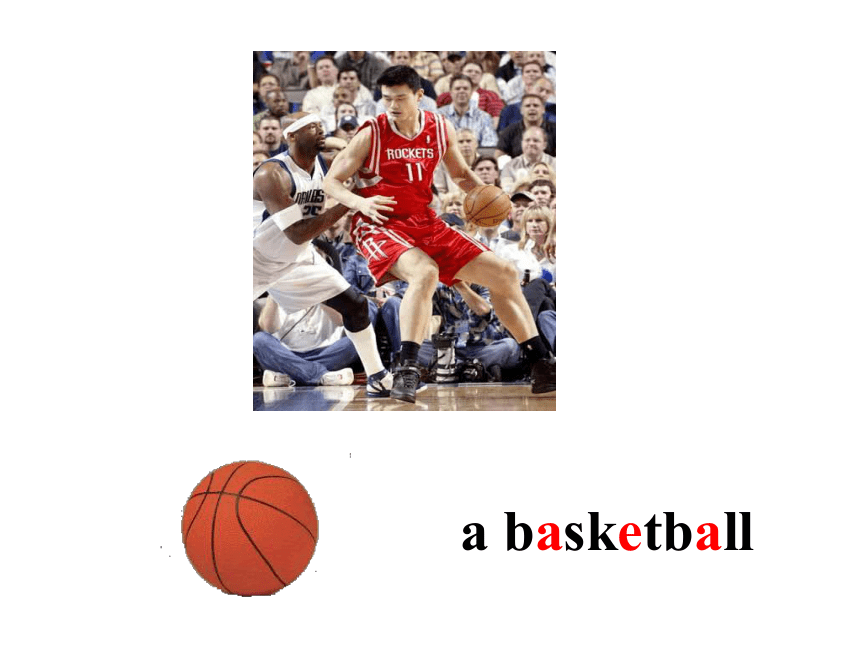
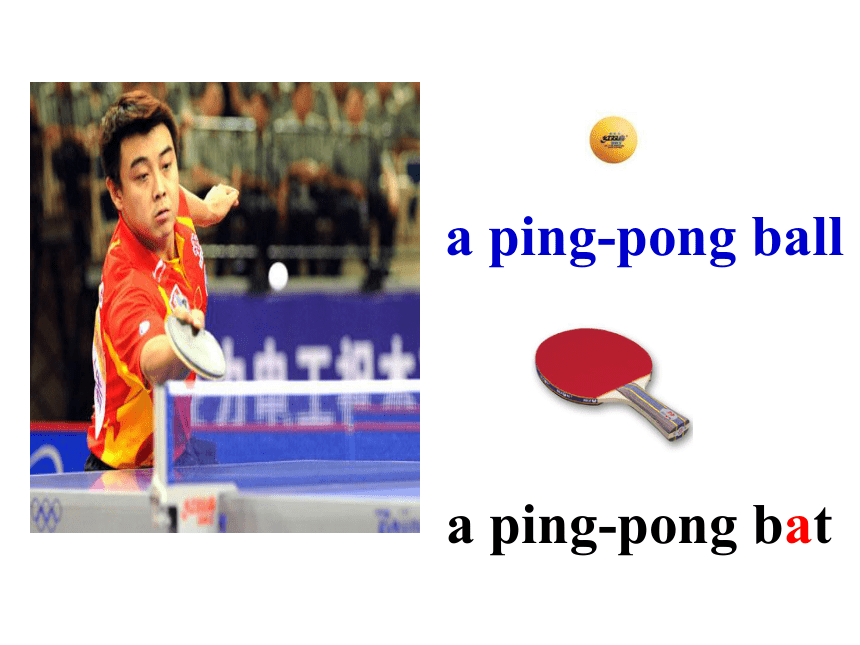
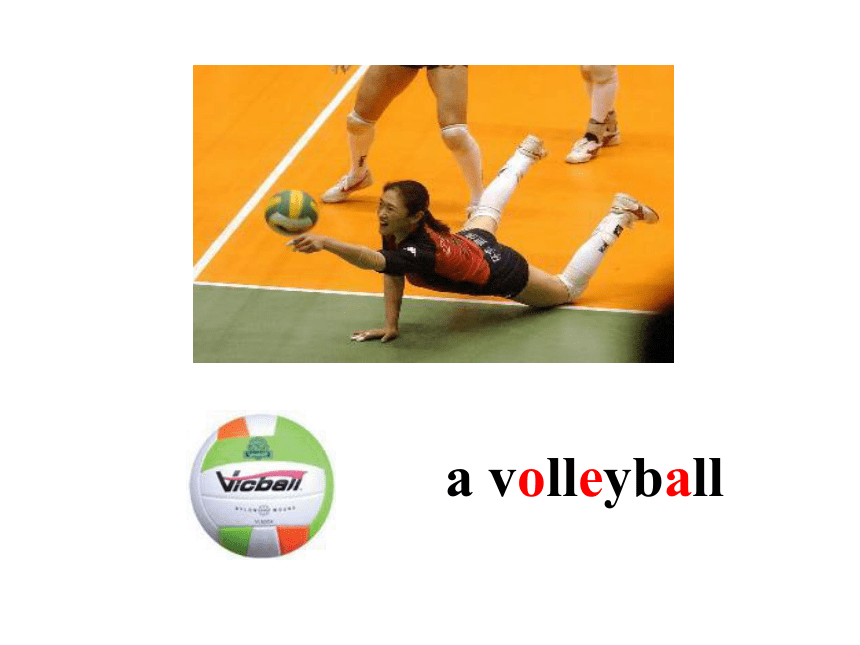
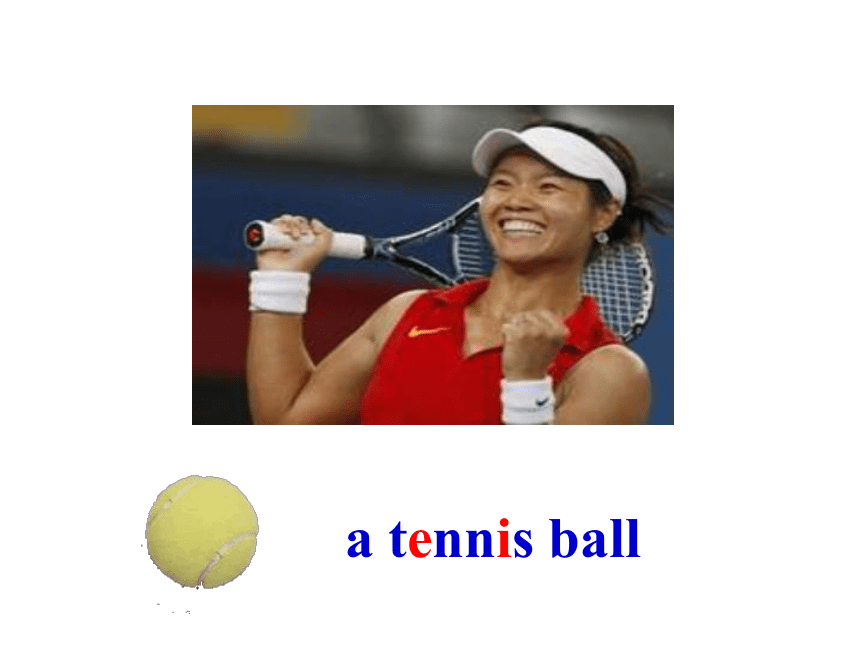
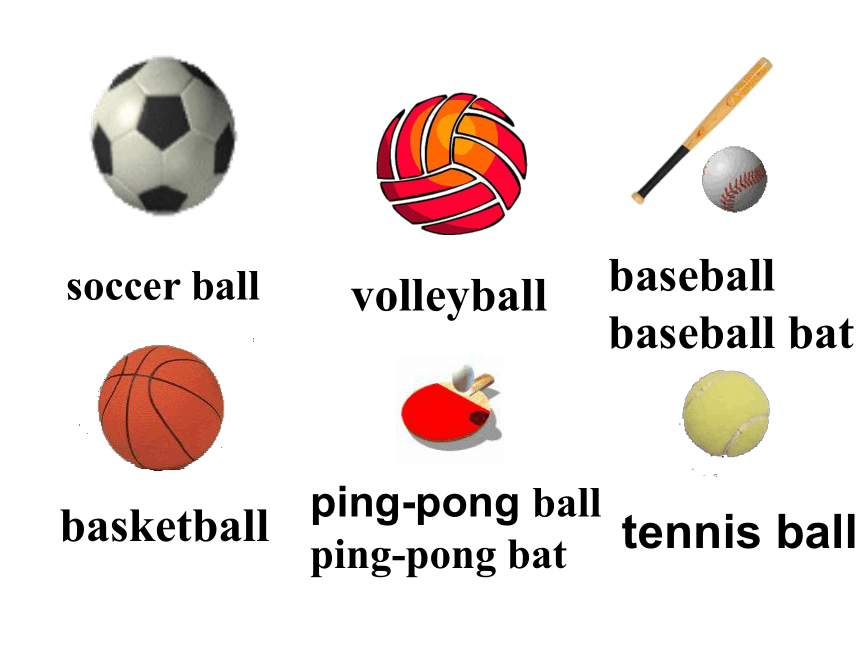
文档简介
(共27张PPT)
Go
for
it!
人教版七年级上册
Unit5 Do you have a soccer ball
SectionA(1a-2d)
学习目标
1) 能掌握下列词汇:do (does), have, tennis, ball, ping-pong, bat等。
2) 学会用have对物品的所属进行提问以及应答,学会使用do和does引导的一般疑问句:
① —Do you have a baseball
—Yes, I do. /No, I don’t.
② —Does she/he have a tennis ball
—Yes, she/he does./ No, she/he doesn’t.
③ —Do they have a soccer ball
—Yes, they do./ No, they don’t.
3) 学会用Let’s… 提建议。
a soccer ball
What’s this
Words and expressions
Presentation
a baseball
a basketball
a ping-pong ball
a ping-pong bat
a volleyball
a tennis ball
basketball
tennis ball
soccer ball
volleyball
baseball
baseball bat
ping-pong ball
ping-pong bat
课文展现
Match the words with the things
in the picture.
tennis ball _____
ping-pong bat _____
soccer ball _____
volleyball _____
basketball _____
baseball bat _____
a
f
c
e
d
b
1a
ping-pong bat soccer ball
volleyball ping-pong ball
Listen and circle the words you hear.
1b
Do you have …
A: Do you have a …
B: Yes, I do. /No, I don’t.
Pair Work
Practice
Summary:
Key words:
basketball, ping-pong, soccer ball, volleyball, ping-pong bat, tennis
2.Key sentences:
Do you have a basketball
Yes , I do. / No, I don’t.
Listen to the conversations and
number the pictures[1-4].
3
2
4
paul
Dale
Jane
Mike
2a
Presentation
Listen again and match the people
with the balls.
3
2
1
4
2b
Role-play the conversation.
Cindy: Hey, Helen, let’s go! We’re late!
Helen: OK.
Cindy: Do you have the baseball
Helen: Yes, I do. It’s in my bag.
Cindy: And where’s our baseball bat
Helen: Bill has it.
Cindy: Oh, yeah. And do you
have your jacket
Helen: Oh, no, I don’t. It’s on
the chair. Let me get it.
Cindy: And your hat, too!
Helen: OK, I have my jacket
and hat. Let’s go!
2d
Match the things with their right places.
the baseball on the chair
the baseball bat in Helen’s bag
Helen’s jacket Bill has it.
1. have作动词,意为“有”,一般指某人拥有某物,侧重于所属关系。其第三人称单数形式是has。
常用句式为:某人 + have/has + 某物.,表示“某人有某物”。
在一般现在时态中,当主语为第三人称单数形式时,用has的形式。
e.g.我有一个好朋友。
I have a good friend.
她有一支新钢笔。
She has a new pen.
2. late “迟到” 是个形容词,常用 be
late 的结构。
e.g.杰克总是迟到。
Jack is always late.
3. we是人称代词主格,意为“我们”,在句子中作主语。
e.g.我们是好朋友。
We are good friends.
4. us “我们”, 是we的宾格形式,在句子
中放在介词或动词后作宾语。
【辨析】we / us / our
we “我们” 是人称代词主格形式,作句子的主语。
us “我们”是人称代词宾格形式,放在介词或动词后作宾语。
our “我们的”是形容词性物主代词,
放在名词前。
e.g.
我们在迈克的房间里。
We are in Mike’s room.
给我们打电话457-3287。
Call us at 457-3287.
我们的老师在教室里。
Our teacher is in the classroom.
5. 以动词let开头的祈使句,表示向别人提
建议,意思是“让……做……吧”。
基本结构为:let sb. do sth.,表示 “让某
人做某事”,表示说话人的建议。其中sb.
可由名词或代词宾格来充当,其后的动
词一定要用动词原形。
e.g. Let me do it. 让我来做吧。
肯定回答:OK./That sounds good!/All right.
否定回答:Sorry,I have to do ……
二、句型转换。
1. Do you have a map (作肯定回答)
2. Do you have an English dictionary (作否定回答)
3. Does Linda have an eraser (作肯定回答)
Yes, I do.
No, I don’t.
Yes, she does.
4. Does he have a volleyball (作否定回答)
5. I have a nice ping-pong bat. (用she来代替I)
______ _______ a nice ping-pong bat.
No, he doesn’t.
She has
Homework
Homework
Homework
1. 复习记忆本课所学的生词。
2. 编写三个问答句,分别询问一下你的朋友是否有足球, 篮球和乒乓球拍。
Go
for
it!
人教版七年级上册
Unit5 Do you have a soccer ball
SectionA(1a-2d)
学习目标
1) 能掌握下列词汇:do (does), have, tennis, ball, ping-pong, bat等。
2) 学会用have对物品的所属进行提问以及应答,学会使用do和does引导的一般疑问句:
① —Do you have a baseball
—Yes, I do. /No, I don’t.
② —Does she/he have a tennis ball
—Yes, she/he does./ No, she/he doesn’t.
③ —Do they have a soccer ball
—Yes, they do./ No, they don’t.
3) 学会用Let’s… 提建议。
a soccer ball
What’s this
Words and expressions
Presentation
a baseball
a basketball
a ping-pong ball
a ping-pong bat
a volleyball
a tennis ball
basketball
tennis ball
soccer ball
volleyball
baseball
baseball bat
ping-pong ball
ping-pong bat
课文展现
Match the words with the things
in the picture.
tennis ball _____
ping-pong bat _____
soccer ball _____
volleyball _____
basketball _____
baseball bat _____
a
f
c
e
d
b
1a
ping-pong bat soccer ball
volleyball ping-pong ball
Listen and circle the words you hear.
1b
Do you have …
A: Do you have a …
B: Yes, I do. /No, I don’t.
Pair Work
Practice
Summary:
Key words:
basketball, ping-pong, soccer ball, volleyball, ping-pong bat, tennis
2.Key sentences:
Do you have a basketball
Yes , I do. / No, I don’t.
Listen to the conversations and
number the pictures[1-4].
3
2
4
paul
Dale
Jane
Mike
2a
Presentation
Listen again and match the people
with the balls.
3
2
1
4
2b
Role-play the conversation.
Cindy: Hey, Helen, let’s go! We’re late!
Helen: OK.
Cindy: Do you have the baseball
Helen: Yes, I do. It’s in my bag.
Cindy: And where’s our baseball bat
Helen: Bill has it.
Cindy: Oh, yeah. And do you
have your jacket
Helen: Oh, no, I don’t. It’s on
the chair. Let me get it.
Cindy: And your hat, too!
Helen: OK, I have my jacket
and hat. Let’s go!
2d
Match the things with their right places.
the baseball on the chair
the baseball bat in Helen’s bag
Helen’s jacket Bill has it.
1. have作动词,意为“有”,一般指某人拥有某物,侧重于所属关系。其第三人称单数形式是has。
常用句式为:某人 + have/has + 某物.,表示“某人有某物”。
在一般现在时态中,当主语为第三人称单数形式时,用has的形式。
e.g.我有一个好朋友。
I have a good friend.
她有一支新钢笔。
She has a new pen.
2. late “迟到” 是个形容词,常用 be
late 的结构。
e.g.杰克总是迟到。
Jack is always late.
3. we是人称代词主格,意为“我们”,在句子中作主语。
e.g.我们是好朋友。
We are good friends.
4. us “我们”, 是we的宾格形式,在句子
中放在介词或动词后作宾语。
【辨析】we / us / our
we “我们” 是人称代词主格形式,作句子的主语。
us “我们”是人称代词宾格形式,放在介词或动词后作宾语。
our “我们的”是形容词性物主代词,
放在名词前。
e.g.
我们在迈克的房间里。
We are in Mike’s room.
给我们打电话457-3287。
Call us at 457-3287.
我们的老师在教室里。
Our teacher is in the classroom.
5. 以动词let开头的祈使句,表示向别人提
建议,意思是“让……做……吧”。
基本结构为:let sb. do sth.,表示 “让某
人做某事”,表示说话人的建议。其中sb.
可由名词或代词宾格来充当,其后的动
词一定要用动词原形。
e.g. Let me do it. 让我来做吧。
肯定回答:OK./That sounds good!/All right.
否定回答:Sorry,I have to do ……
二、句型转换。
1. Do you have a map (作肯定回答)
2. Do you have an English dictionary (作否定回答)
3. Does Linda have an eraser (作肯定回答)
Yes, I do.
No, I don’t.
Yes, she does.
4. Does he have a volleyball (作否定回答)
5. I have a nice ping-pong bat. (用she来代替I)
______ _______ a nice ping-pong bat.
No, he doesn’t.
She has
Homework
Homework
Homework
1. 复习记忆本课所学的生词。
2. 编写三个问答句,分别询问一下你的朋友是否有足球, 篮球和乒乓球拍。
同课章节目录
- starters 预备篇(2012秋审查)
- Unit 1 Good morning !
- Unit 2 What’s this in English?
- Unit 3 What color is it ?
- Unit 1 My name's Gina.
- Section A
- Section B
- Unit 2 This is my sister.
- Section A
- Section B
- Unit 3 Is this your pencil?
- Section A
- Section B
- Unit 4 Where's my schoolbag?
- Section A
- Section B
- Unit 5 Do you have a soccer ball?
- Section A
- Section B
- Unit 6 Do you like bananas?
- Section A
- Section B
- Unit 7 How much are these socks?
- Section A
- Section B
- Unit 8 When is your birthday?
- Section A
- Section B
- Unit 9 My favorite subject is science.
- Section A
- Section B
